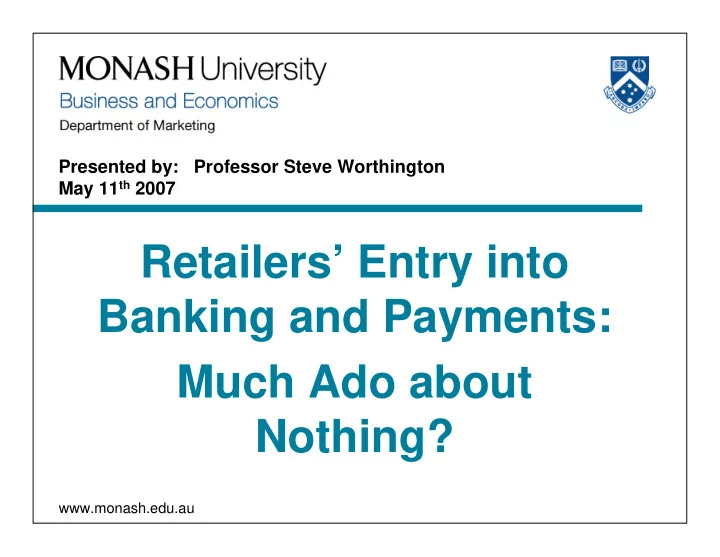

Presented by: Professor Steve Worthington May 11 th 2007 Retailers’ Entry into Banking and Payments: Much Ado about Nothing? www.monash.edu.au
Why are Retailers Interested in Banking and Payments? � Firstly, they want to offer banking services to their customers, to widen their product proposition. � Secondly, they want to reduce the costs of accepting customers’ payments, particularly card payments! Department of Marketing 2
Banking at the Checkout? � Both reasons involve moving into traditional bank territory, either by competing in the supply of banking services to personal customers or by taking acquiring ‘in-house’. � What then are the differences between retailers and bankers? Department of Marketing 3
Department of Marketing 4
How have retailers across the world sought to enter the banking market? � Use the UK as one example � Retailer entry strategies – 2 options � The Store Card as a platform � Best UK e.g.: Marks & Spencer (M&S) � The Loyalty Card as a start point � Best e.g.: Tesco and Sainsbury’s Department of Marketing 5
M&S Financial Services � M&S ran its own store card rather than outsource, as many others did. � This gave M&S knowledge and skill sets which they used as a platform for the wider provision of financial services, e.g., personal loans, mutual funds, savings and life insurance. Department of Marketing 6
M&S Money � Re-branded as M&S Money (10/03) � Launched a MasterCard badged credit and rewards card in 10/2003 � 1.7 million Chargecard holders converted + 380K new accounts � All 2.1 million cards + all M&S Money sold to HSBC in 11/04 Department of Marketing 7
Loyalty Cards as an Entry Point � The ‘one-stop-shop’ approach is based around being a provider of solutions to customers and hence ‘supermarket’ groups added to their propositions by including services. � To identify their customers and their needs, they used ‘loyalty cards’ Department of Marketing 8
The Tesco Clubcard � Launched in 2/95 as the first such card – quickly reached 10 million � Reinforces the brand + ‘loyalty’ � Application form plus subsequent use and redemption generates data on the identity and behaviour of customers; helps target better offers Department of Marketing 9
Tesco Personal Finance (TPF) � Unlike M&S, the supermarkets did not have banking skills, so they partnered with existing banks to produce their ‘own-label’ products. � Tesco has a joint venture with the Royal Bank of Scotland (RBS) to create TPF – now over 5 m accounts Department of Marketing 10
Sainsbury’s Loyalty Card/Bank � Followed Tesco and launched in 6/96 – also 10 million cardholders � Sainsbury’s also followed Tesco into banking, creating Sainsbury’s Bank in 02/97, as a joint venture with Bank of Scotland (now HBOS) � Had 2.5 m customer accounts by 2006 Department of Marketing 11
Only a Limited Offer! � Retailers have only competed with selective products; cards, loans, etc. � No retailer has a cheque/current account and hence customers are forced to have other bank accounts � Unsecured lending has been their game, but this is more risk prone! Department of Marketing 12
Services offered M&S Money Tesco PF Sainsbury’s Deposit accounts O O O Current accounts Store cards O MasterCard / Visa O O O credit cards Personal loans O O O Mortgages O ISA O Unit trust O NS&I savings O products Child trust fund O Travel money O O O Department of Marketing 13
Presence by market Current accounts No presence � Both TPF and Sainsbury’s Bank with portfolios of >£2bn Savings accounts � But UK mkt of >£550bn at end 2005 � Marginal presence Mortgages � Only TPF currently offers mortgages Credit cards and � Unsecured loan books of £2-3bn each consumer loans � But UK market of approx. £190bn Department of Marketing 14
Reducing the costs of payments. � In Australia, two major retailers have become ‘on-us’ acquirers of all card transactions – they sort and then send directly to card issuers � The Australian regulator has already intervened in the market and reduced interchange to 0.5% Department of Marketing 15
The Australian Experience � An interchange benchmark for debit cards (MasterCard and Visa) has also been established (12A cents) � Merchants can and do surcharge for credit/charge transactions � The ‘Honour all Cards’ rule has been abolished for both credit/debit Department of Marketing 16
Retailers Entry into Banking and Payments � Much Ado about Nothing? � Or is it more The Merchant of Venice? � And are retailers now looking for their ‘Pound of Flesh’? � ? Can co-opetition (the mix of co- operation and competition) succeed? Department of Marketing 17
Recommend
More recommend